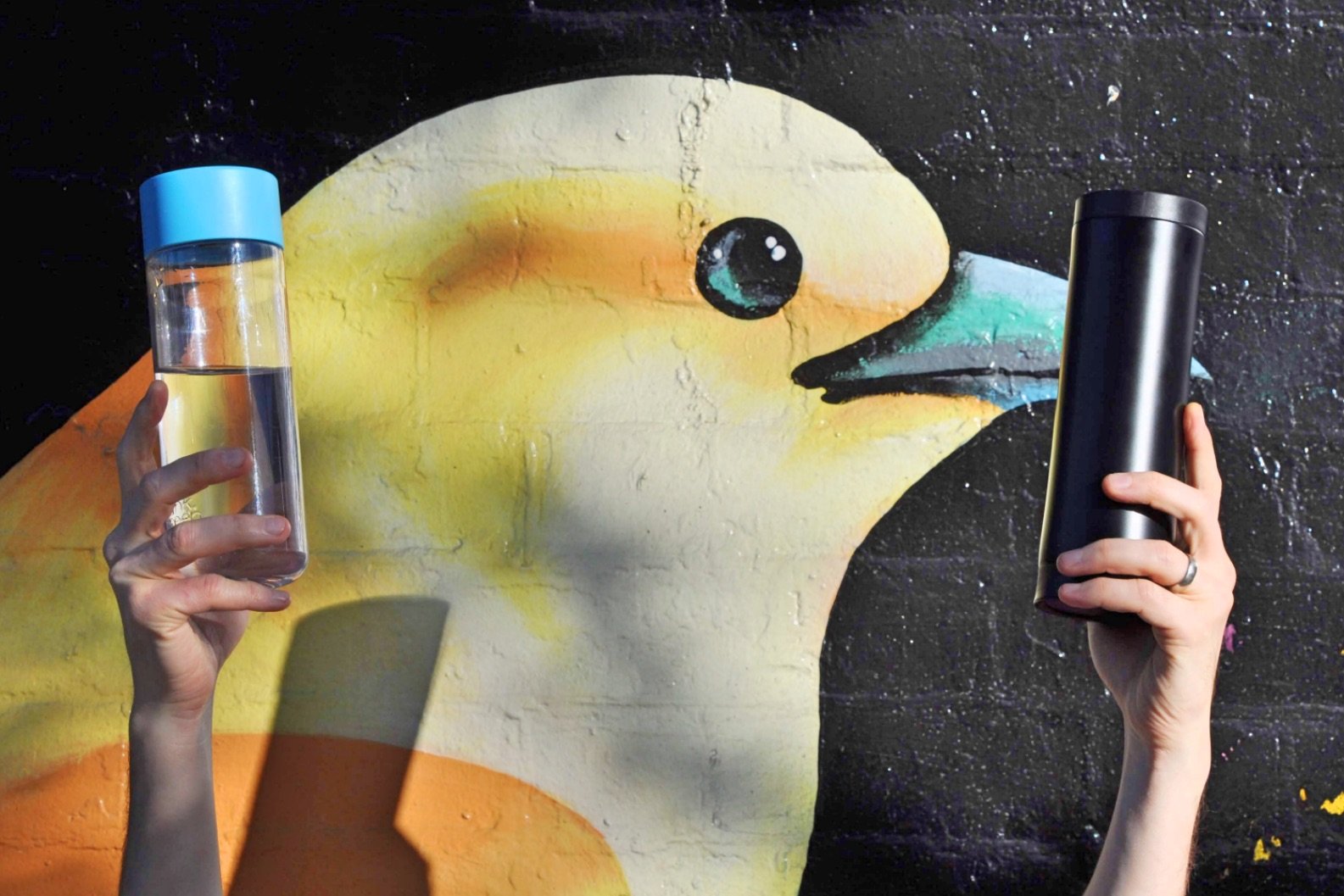How To Avoid Plastic Water Bottles When You Can't Drink The Tap Water
It’s easy to avoid bottled water when you’re in a country with safe drinking water, but it is much harder to avoid when you live in or are travelling in a country with tap water that is undrinkable. How can you avoid water in plastic bottles, as well as getting sick from drinking unsafe tap water?
Not all tap water is safe to drink. What if you live in a town or travel to one where the water is unsafe to drink? How can you avoid water in plastic bottles, as well as getting sick from drinking unsafe tap water?
Here’s 6 strategies you can choose from...
1. Fill your normal reusable water bottle up at hotels and restaurants
Most hotels and restaurants will have drinkable water available for tourists in countries where those travelling in it can’t drink the tap water.
Ask at the reception desk or the restaurant at your accommodation if they could fill up your water bottle for you. You can also ask waiters and waitresses at cafes and restaurants that you go to if they have a way for you to fill up your water bottle.
Also, keep an eye out for water fountains offering free drinkable water. You’ll usually find these in countries where even the locals can’t drink the tap water.
There are apps that show where safe drinking water refill stations are. These include the Choose Tap (for Australia), Refill (UK based) , Refill Bali (for Bali), and Refill My Bottle (worldwide) apps.
Fill your water bottle up in the morning before you head out exploring and wherever you end up eating your meals that day.
2. Fill your normal reusable water bottle up with boiled water
If you have access to a kettle, you can sterilise water by boiling it.
According to the Centers for Disease Control and Prevention (CDC), “boiling can be used as a pathogen reduction method that should kill all pathogens”. To kill all pathogens it says that the water should be brought to a rolling boil for 1 minute, while at altitudes greater than 6 562 feet/2 000 metres, it should be boiled for 3 minutes.
If boiling water is not possible, the organisation recommends a combination of filtration and chemical disinfection for effective pathogen reduction in drinking water. It stresses that manufacturers’ instructions must be followed.
3. Sterilise the water with a SteriPen water steriliser
The SteriPen is well liked and recommended by many travellers. It is a portable ultraviolet (UV) water purifier that destroys viruses, bacteria and protozoa. The lamp is activated by the minerals in the water when it touches the water. It is then stirred in the water to destroy microbes that can cause waterborne illnesses.
An alternative to using harmful chemicals to purify water, UV light does not change the taste, odour or colour of the water. It is, however, an expensive option.
A Water Quality Association Gold Seal provides certification that SteriPen purifies water safely and effectively.
Tips:
You’ll need a wide-mouthed bottle to sterilise the water in - the minimum diameter opening needed for a SteriPen Adventurer Opti and Traveler Mini is 1.6 inches or 40.6 millimetres, while for all other models, the minimum diameter opening is roughly 1 inch or 25.4 millimetres.
It takes 3 minutes to sterilise 500 millilitres, so sterilise the local water while at your accommodation and fill up a few water bottles for the day.
Some require batteries, while others are USB chargeable - compare the various models to find the best one for your needs.
4. Use water purification drops or tablets
Water purification drops and tablets use chemicals to purify drinking water. The drops or tablets are simply put in the water and you wait for them to dissolve. It usually takes around 30 minutes to get clean water that is safe to drink.
They usually contain either chlorine, chlorine dioxide or iodine as an active ingredient. They make water safe for consumption by deactivating bacteria, viruses and parasitic protozoans.
The benefits of these are that they are easy to use and carry around and they don’t any special equipment, batteries or electricity.
However, sediment may have to be filtered out before using purification drops and tablets and not all microorganisms are killed by these chemicals.
When choosing a water purification drop or tablet, look into:
What it kills - does it just kill bacteria and viruses, or cryptosporidium as well?
How long it takes to purify the water - while chlorine dioxide kills the widest range of microorganisms, it has a long treatment time.
Its taste and smell - some can taste incredibly chemical and have a strong chemical smell.
Aquatabs are the most well-known water purification tablets, but they don’t seem to come plastic free. Certain brands like Katadyn Micropur Forte water purifier tablets come in foil packaging and a cardboard box, so the packaging is recyclable.
5. Use a mini water filter
Mini filtration devices can be attached to drinking pouches, connected to hydration pack tubing, or screwed onto standard disposable water and soda bottles. It then filters the water while you drink it.
According to the CDC, “filtration can be used as a pathogen reduction method against most microorganisms, depending on the pore size of the filter, amount of the contaminant, particle size of the contaminant, and charge of the contaminant particle”.
And this is only if manufacturer’s instructions are followed. The organisation also notes that “only filters that contain a chemical disinfectant matrix will be effective against some viruses”.
How to know whether a filter design is suitable for the removal of Cryptosporidium is shared in detail here.
You may want to find a filter that doesn’t require disposable filters, like the Sawyer mini water filter, to reduce the amount of waste produced, however rather get an effective filter than one that produces less waste (if you end up in hospital you’re going to create heaps of waste).
The Sawyer Mini Water Filtration System has, however, been recommended to me and gets good reviews. Other options are the Katadyn Vario ceramic water filter purifier, the LifeStraw Personal Water Filter and the MSR MiniWorks EX filter.
6. Get a water bottle with an inbuilt water filter
Another option is to buy a water bottle that has an inbuilt filter like the Lifestraw Water Bottle, the Oko filtered water bottle and the Grayl Portable Water Purifying Bottle.
Be wary which one you buy though, as not all of these types of bottles remove viruses or diseases. Some are not designed for use when travelling in developing countries, but are only designed to filter chlorine and odours and improve taste. The same goes for Binchotan charcoal filter sticks, which only reduce pH and absorb toxins like chlorine.
If you do only need to naturally absorb any toxins such as chlorine, lead, mercury, cadmium and copper from your tap water, you can get them in Australia here, in the UK here and in the US/Canada here. They also release minerals into water, including calcium, potassium, magnesium, and phosphates.
The best options depends on where you're travelling to, whether you will be in cities or far from civilisation and what facilities you have on hand, for example if you have access to a kettle or not.
Whichever strategy you choose, remember that your health comes first! Don't dehydrate or drink dodgy water for the sake of saving a single plastic water bottle.
*this post contains affiliate links. If you buy something from a featured brand we may earn a small amount. To learn more, see our disclosure policy. We maintain this site in our free time and support in any way, shape or form means a lot and helps us keep it running, whether it is using an affiliate link when investing in something, sharing our content, or buying us a coffee on Ko-fi.



